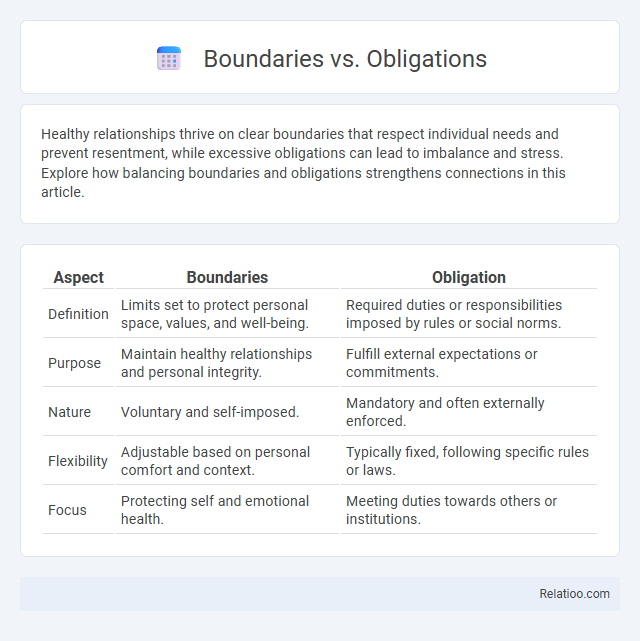Healthy relationships thrive on clear boundaries that respect individual needs and prevent resentment, while excessive obligations can lead to imbalance and stress. Explore how balancing boundaries and obligations strengthens connections in this article.
Table of Comparison
| Aspect | Boundaries | Obligation |
|---|---|---|
| Definition | Limits set to protect personal space, values, and well-being. | Required duties or responsibilities imposed by rules or social norms. |
| Purpose | Maintain healthy relationships and personal integrity. | Fulfill external expectations or commitments. |
| Nature | Voluntary and self-imposed. | Mandatory and often externally enforced. |
| Flexibility | Adjustable based on personal comfort and context. | Typically fixed, following specific rules or laws. |
| Focus | Protecting self and emotional health. | Meeting duties towards others or institutions. |
Understanding Boundaries: A Clear Definition
Understanding boundaries involves recognizing personal limits that define acceptable behavior and protect individual well-being, distinct from obligations which are duties or commitments to others. Boundaries serve as guidelines for self-care and maintaining healthy relationships, while obligations often require fulfilling responsibilities despite personal discomfort. Clear boundary definition helps prevent overcommitment and ensures obligations do not undermine personal autonomy or emotional health.
The Nature of Obligation: What Does It Mean?
The nature of obligation involves an inherent duty or responsibility that compels individuals to act according to moral, legal, or social rules. Unlike boundaries, which define personal limits and protect autonomy, obligations impose external or internal commitments that guide behavior. Understanding obligation requires recognizing its role in ensuring accountability and maintaining social order through adherence to prescribed norms.
Key Differences Between Boundaries and Obligation
Boundaries define your personal limits and protect your mental and emotional well-being, while obligations are duties or responsibilities you are expected to fulfill. Your boundaries are self-imposed and based on your values, helping you manage how others treat you, whereas obligations often stem from external expectations such as work or family commitments. Understanding these key differences ensures you can assert your rights without neglecting necessary responsibilities.
Why Setting Boundaries Matters
Setting boundaries protects your mental and emotional well-being by clearly defining what you are willing to accept, preventing resentment and burnout. Understanding the difference between boundaries and obligations empowers you to prioritize tasks and relationships that align with your values while avoiding unnecessary stress. Your ability to enforce boundaries ensures long-term personal growth and healthier interactions in both professional and personal environments.
Social and Cultural Influences on Obligations
Social and cultural influences shape obligations by defining accepted behaviors and roles within communities, impacting how you perceive duties and responsibilities. Boundaries help individuals manage these expectations by setting limits on what is acceptable in social interactions, preventing overextension. Cultural norms often blur the lines between personal boundaries and obligations, making it essential to balance respect for traditions with your own needs.
Recognizing When Obligation Crosses Healthy Boundaries
Recognizing when obligation crosses healthy boundaries is essential for maintaining mental and emotional well-being, as excessive obligation can lead to burnout and resentment. Healthy boundaries involve setting limits on the responsibilities one accepts, ensuring obligations do not infringe on personal time, values, or self-care. Understanding the difference between supportive commitments and overwhelming demands helps individuals prioritize their needs while fulfilling responsibilities effectively.
Practical Strategies for Maintaining Boundaries
Setting clear boundaries helps you distinguish personal limits from obligations, preventing burnout and fostering healthier relationships. Use assertive communication to express your needs and say no when necessary without guilt. Prioritize tasks by assessing genuine obligations versus optional commitments to maintain balance and respect your time effectively.
The Impact of Guilt in Navigating Obligations
Guilt significantly influences how you navigate boundaries and obligations, often blurring the distinction between personal limits and external demands. When guilt drives compliance with obligations, it can lead to emotional exhaustion and weaken your ability to maintain healthy boundaries. Recognizing guilt's role helps restore balance, allowing you to fulfill obligations without sacrificing your well-being.
Communicating Boundaries Effectively
Communicating boundaries effectively requires clearly expressing personal limits while respecting others' needs to maintain healthy relationships and prevent misunderstandings. Differentiating between boundaries--personal limits set to protect well-being--and obligations--duties imposed by roles or commitments--helps clarify expectations and reduce conflicts. Employing assertive communication techniques, such as using "I" statements and being consistent, strengthens boundary-setting without dismissing legitimate obligations.
Achieving Balance: Respecting Both Boundaries and Obligations
Achieving balance between boundaries and obligations requires understanding your personal limits while fulfilling responsibilities effectively. Respecting boundaries means recognizing when to say no and protecting your well-being, whereas honoring obligations involves commitment to tasks and promises that impact your relationships and goals. You can create harmony by prioritizing tasks without compromising your mental health, ensuring both boundaries and obligations contribute to your overall success and fulfillment.

Infographic: Boundaries vs Obligation
 relatioo.com
relatioo.com